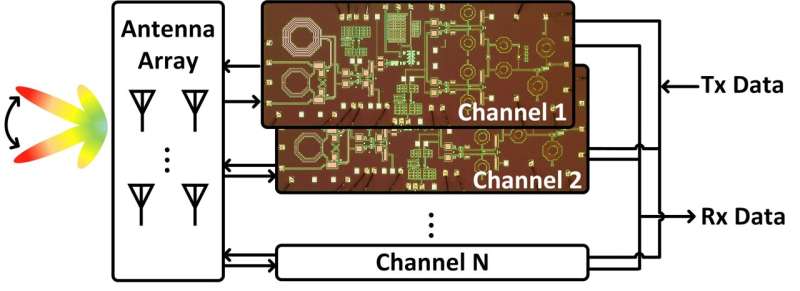This article has been reviewed according to Science X's editorial process and policies. Editors have highlighted the following attributes while ensuring the content's credibility:
fact-checked
proofread
A retrodirective array enabled by CMOS chips for two-way wireless communication with automatic beam tracking

Beam directive communication at millimeter-wave and even higher frequencies is of significant global interest. By leveraging advanced array technologies, electromagnetic waves can be focused in specific directions for millimeter-wave transmission and reception, thereby maximizing the signal power in the intended direction while suppressing interference from others.
This capability improves signal quality, coverage, and spectral efficiency. To achieve beam steering, classical arrays employ phase-shifting techniques that increase controlling complexity, power consumption, and cost.
Retrodirective arrays (RDAs) possess the distinct capability of autonomously tracking incoming signals and retransmitting them backward to the source. RDAs perform real-time tracking and beam steering without requiring prior knowledge of the source position. Moreover, RDAs avoid the need for complex digital signal-processing (DSP) algorithms, which often impose significant demands in terms of computation time and power resources.
However, conventional RDAs do not support two-way communication, as they are limited to receiving continuous wave (CW) signals rather than modulated signals; in addition, they also suffer from unavoidable beam pointing errors (BPEs). Moreover, published RDAs rely on bulky, discrete modules, resulting in a large and cumbersome system size.
In a recently published paper in Engineering, a research team from Southeast University and Purple Mountain Laboratories proposed and demonstrated a highly integrated RDA for two-way wireless communication with automatic beam tracking. The proposed RDA is enabled by specifically designed chips using a complementary metal-oxide semiconductor (CMOS) process.
The highly integrated CMOS chip includes a receiving (Rx) chain, a transmitting (Tx) chain, and a unique tracking phase-locked loop (PLL) for the crucial conjugated phase recovery in the RDA. This is the first published RDA enabled by specifically designed CMOS chips for wireless communication.
Each CMOS chip in the RDA has a size of 4.62 mm2 and a low power consumption of 0.15 W. The proposed RDA with CMOS chips was experimentally validated. Moreover, the RDA was demonstrated to perform in an indoor scenario; the demonstration indicates its ability to track the beam within a coverage up to 80° automatically.
The demonstration also showed that the proposed RDA offers a promising solution for mobile communication, with improved performance in real-time automatic tracking and beam steering. Moreover, the proposed RDA has the potential to be extended to higher frequency bands.
More information: Jiacheng Guo et al, A Retrodirective Array Enabled by CMOS Chips for Two-Way Wireless Communication with Automatic Beam Tracking, Engineering (2024). DOI: 10.1016/j.eng.2023.12.010



















